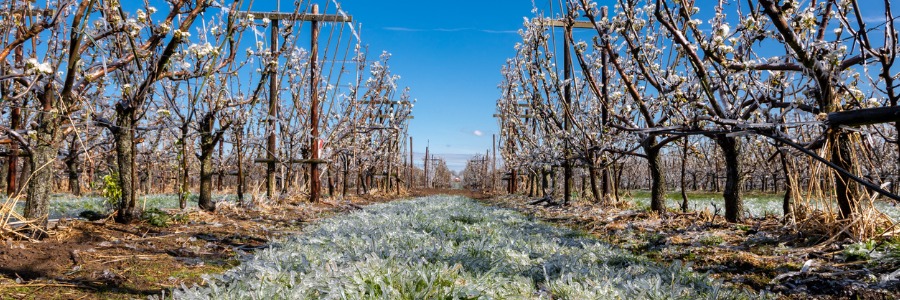
As daylight hours begin to wane in late Summer, trees begin preparing for the oncoming Winter at the cellular level to increase their cold tolerance. Shrinkage, sugar concentration and dehydration are happening, and their metabolism slows as they enter a state of dormancy. By mid-Winter, they reach their adapted tolerance, their cells now hardened and glasslike to prevent freezing and damage to their living cells. But even though they are in a dormant state, all trees still need water to live through Winter.
ABOVE GROUND
Above ground, trees are continually losing water as they take up water from the soil and release water vapor into the atmosphere from their leaves. Because evergreens transpire more than deciduous trees, they suffer more throughout the Winter. When the amount of water lost through transpiration is greater than the amount tree roots take up from the soil over Winter months, damage to the tree appears as brown needles or leaves on branch tips in the Spring, even though the tree remained green throughout the Winter. This is called Winter Desiccation, which can be managed through Winter watering and/or desiccant sprays.
BELOW GROUND
Although trees go into a dormant state throughout Winter, deep beneath the ground surface, their extensive root systems are very much alive and working, continually reaching for water and nutrients to take up into the trunk and leaves to serve critical metabolic and physiological functions that keep the tree alive. Some of the water taken up into the tree is released into the atmosphere through its foliage as transpiration. Therefore, it’s important to make sure the soil deep beneath the ground surface around a tree’s root system contains enough moisture over Winter months to keep the tree hydrated during its dormancy.
During Winter, watering established trees and evergreens is only necessary one to two times a month until Spring. Watering should be done mid-day when the ground is not frozen, and the temperature is at least 40-45 degrees Fahrenheit. When Winter winds blow harsh and frigid, surface soils dry out and freeze quickly. Dry soils lose their natural insulating properties, and fine tree roots close to the surface will wither and die. Decomposition of organic matter in the soil also slows from lack of water, and soil organisms die—both of which are needed for long-term soil health.
Although snow and ice do insulate the soil surface, they don’t add water to soil until it melts. It generally takes about 10 inches of snow to melt into one inch of water. If snow is heavy and wet, it would take four or five inches to melt into one inch of water because of its much higher water content.
Young and newly planted trees are affected immediately without water insulating the soil they’re planted in. A hard freeze will kill a young tree’s fine root system since roots are close to the surface. Because older, established trees have extensive root systems deep beneath the ground surface, they can often find water in surrounding soils, so they are not as affected by dry Winter surface soils above.
When watering trees both young and old it should be done slowly, as dry surface soils tend to resist water at first. Water needs to seep down at least a foot or more into the soil. Always water away from a tree’s trunk where surface roots have developed. Mulching that was placed around a young tree when planted can be used as a guide for where to water. The drip line of established trees can be used as a measurement for where to water.
While keeping soils from drying out in Winter, take care also not to overwater. Too much water can suffocate soil by excluding oxygen that roots need. Too much water will also encourage the growth of soil fungus and bacteria that can damage trees. Knowing how moist or dry the soil is deep beneath the ground surface around root systems is key for keeping trees and plants healthy. Baseline’s Soil Moisture Sensors can accurately measure soil moisture from 5% moisture to full saturated, as well as soil temperature. Using cutting edge, patented modified TDT technology, these ultra-sensitive soil moisture sensors work by sending a high frequency pulse of electricity down an embedded wire path through soils surrounding root systems. When it travels through moisture, the sensor slows down and measures the speed of the pulse, then converts the measurement to a moisture content reading to within ±3% of the actual volumetric soil moisture content for most efficient irrigation of trees, evergreen shrubs, and all plants in every season.
Watering trees during dormancy is not going to wake them up. On the contrary, keeping them watered throughout Winter is going to keep them strong and healthy, as below ground, their root systems are actively maintaining chemical changes that control their dormancy.

Guide: Sustainability in the Retail Industry
a comprehensive guide on how retail companies can enhance sustainability by implementing water-saving strategies.
Water Conservation is a Win-Win for Wendy’s
Since implementing this technology, Wendy’s has seen a 50% reduction in irrigation water use, while tracking to save more than one million gallons of irrigation water in 2021 alone.

Smart Water Management Helps Leading Retail Company Achieve ESG and Sustainability Goals
Discover how a leading retail company met its ESG sustainability goals by implementing smart water management strategies, resulting in significant water savings and improved efficiency.


